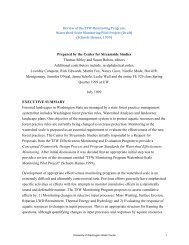Copyright 2012 Aileen M. Echiverri-Cohen - University of Washington
Copyright 2012 Aileen M. Echiverri-Cohen - University of Washington
Copyright 2012 Aileen M. Echiverri-Cohen - University of Washington
You also want an ePaper? Increase the reach of your titles
YUMPU automatically turns print PDFs into web optimized ePapers that Google loves.
studies show a correspondence between decreased cognitive activation in the prefrontal region<br />
(e.g., decreased P3 amplitude, decreased regional cerebral blood flow) and decreased reaction<br />
time or decreased accuracy on response tasks in individuals with PTSD compared to those<br />
without psychopathology (e.g., Boudarene & Timsit-Berthier, 1997; McFarlane, et al., 1993;<br />
Galletly et al., 2001; Clark et al., 2003; Shaw et al., 2002; Semple et al.; 1996; Vasterling et al.,<br />
1998, 2002; Koso & Hansen, 2006; Navalta et al., 2006; Beers et al., 2002). However, many <strong>of</strong><br />
these studies suffer from low sample sizes, lack <strong>of</strong> comparison groups to control for trauma<br />
exposure, or failure to control for such things as history <strong>of</strong> psychotropic treatment and substance<br />
use. Nevertheless, the initial pattern <strong>of</strong> results suggests that deficient inhibitory processes<br />
underlie, at least in part, the poor cognitive performance in tasks using trauma-neutral stimuli<br />
and the decreased activity in the prefrontal brain regions observed in individuals with PTSD.<br />
Two relevant measures <strong>of</strong> inhibition are attentional blink (AB; Raymond, Shapiro, &<br />
Arnell, 1992), a behavioral measure assessing reduced ability to direct attention to multiple<br />
stimuli in a visual stream, and prepulse inhibition <strong>of</strong> startle (PPI; Braff & Geyer, 1990), a<br />
psychophysiological measure evaluating the strength <strong>of</strong> inhibition in gating irrelevant<br />
information. The AB is a cognitive paradigm that is thought to be linked to inhibitory processes<br />
by directing attentional resources to one target thereby affecting the processing <strong>of</strong> the subsequent<br />
target (Raymond et al., 1992). Using a rapid serial visual presentation sequence (RSVP) in which<br />
target (T) stimuli (e.g., letters) are embedded in a stream <strong>of</strong> distractor (D) stimuli (e.g., numbers;<br />
Raymond, et al., 1992), participants are instructed to identify the first and second targets from a<br />
set <strong>of</strong> possible targets that are separated by intervening distractors also referred to as a lag (L).<br />
Individuals typically show high rates <strong>of</strong> correct identification <strong>of</strong> both targets under a Lag 1<br />
condition (e.g., no intervening distractors between targets); however, individuals typically show<br />
7
















